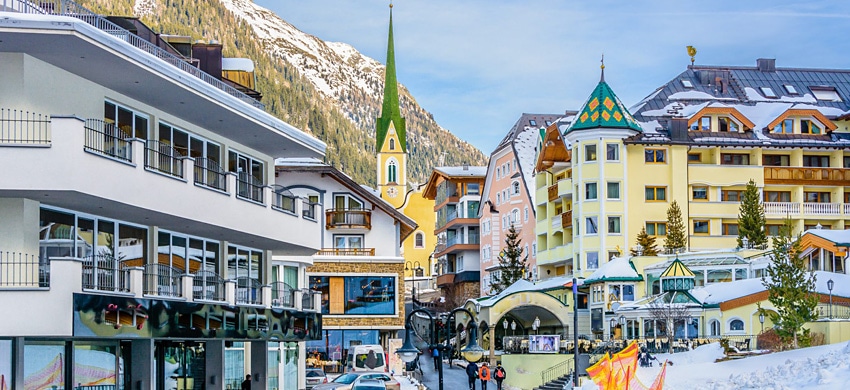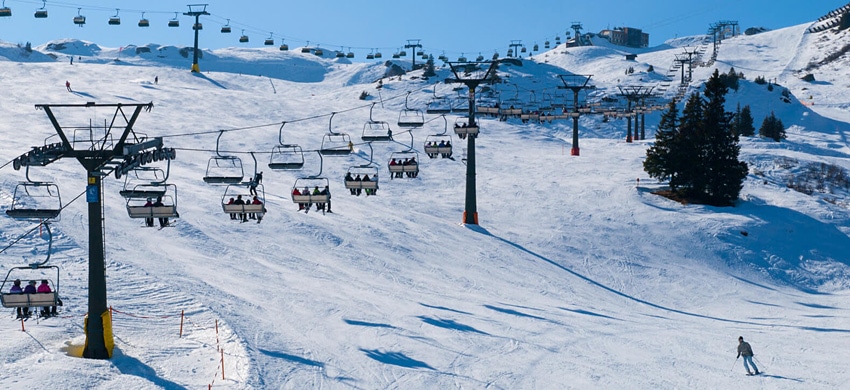

Visiting it out of season, you would never guess that Ischgl, a Tyrolean village of 1,500 souls, turns into Europe’s snow fun capital in winter. Discos, clubs, plenty of apres-ski venues right on the slopes and even at altitude, concerts on the snow and much more, a world of excess so much so that skiing almost seems to take second place.
And indeed, this is exactly how it is in Ischgl, which is taken by storm every winter by a multitude of tourists, especially British and northern Europeans, who are more interested in snow parties and nightlife than in skiing. This scares off many ski and winter sports enthusiasts, who often head for other, quieter places where they can enjoy the slopes and rest after skiing.
And underneath it all, it is a shame, because Ischgl really deserves to be appreciated for what it is, the beating heart of the Silvretta Arena Ischgl-Samnaun ski area, which stretches between Austria and Switzerland on no less than 239 kilometres of pistes and a further 15 kilometres of off-piste runs, connected by more than 40 modern and efficient lifts.
But Ischgl is also a destination worth visiting in the summer: in this season it becomes a ‘normal’ summer resort for the whole family, in the middle of a beautiful valley, and an excellent starting point for high mountain hikes or leisurely walks in the valley floor.

In winter, there are essentially two things to do in Ischgl: skiing and partying! But this Tyrolean village is also popular in summer, although the clientele is completely different. So here are the best things to do in Ischgl, to make the most of your holiday season by season.
An adrenaline-fuelled two-kilometre-long zip-line ride, travelling at up to 85 kilometres per hour. This is the Skyfly, an experience that allows you to admire the panorama of Ischgl and its surroundings from a completely different perspective. In winter you can admire the magnificent ski slopes and snow-covered mountains, while in summer you can enjoy the Tyrolean nature in all its splendour from above.
The SkyFly route starts at the middle station of the Silvrettabahn cable car, at an altitude of 1683 metres, and ends on the roof of the valley station of the 3-S Pardatschgratbahn cable car, at an altitude of 1376 metres. The trip is divided into three sections called Opening (89 seconds), Relax if you can (73 seconds) and Closing (30 seconds). The maximum speed of 85 kilometres per hour is achieved in the intermediate section, Relax if you can.
In summer, Ischgl offers several swimming pools where you can relax and swim. Of all of them, the spectacular Waldbad, a water park in the middle of the forest with a large pool and a 47-metre long slide, is worth mentioning. There is fun here for young and old, and everyone will find their ideal environment, thanks to the ample space available. You can spend a relaxing day on the lawn or in the shade of a tree, or take centre stage by the pool.
If you are in Ischgl in winter and feel like diving, head for the Silvretta Center, a multi-purpose centre located in the town centre, which presents itself as an alternative to outdoor sports. The Silvretta Centre is popular with tourists, as it has an indoor swimming pool, a sauna and a series of wellness trails.
Near the Vidersee lake is the Vider Truja, an adventure park for young and old. The entire park revolves around the water environment, and can be reached on foot, with a two-hour walk from Ischgl to Idalp (2320 metres), via suspension bridges and three areas of alpine vegetation, or in a more comfortable and quicker, but certainly less sporty way, via the Silvrettabahn cable car.
Once in Idalp, the Vider Truja adventure park is only five minutes away. Inside, a circular course surrounded by the spectacular Tyrolean mountains passes through various water environments enhanced by mills, pumps, and a free climbing section. There is also a section dedicated to barefoot walking, on different surfaces designed to massage the soles of the feet and promote blood circulation.

Between the Silvretta and Verwall mountains, Ischgl provides the best winter holiday experience thanks to 239 kilometres of perfectly groomed ski pistes, cross-country ski trails and various off-piste trails. Snow is guaranteed from the end of November to the beginning of May, and the area is equipped with ski schools, ski buses, snow parks, ski depots and skating and toboggan runs.
Skiing in Ischgl takes you up to an altitude of 2,872 metres, within the Silvretta Arena ski area that reaches all the way to the Swiss town of Samnaun in the canton of Graubünden, in what is the third largest ski area in the Tyrol.
Ischgl is a fairly compact town, which can be covered from top to bottom in about 15-20 minutes on foot. Choosing where to stay depends very much on the season you intend to visit and the type of holiday you intend to take. In winter, discerning skiers will want a hotel within walking distance of the ski lifts, or directly on the slopes. Some will want to be close to the après-ski venues, while others will want peace and quiet as soon as they take off their skis and boots; for this type of holidaymaker, it is advisable to stay in the Paznaun area, across the Trisanna river, away from the hustle and bustle of the centre.
In summer, on the other hand, we recommend staying close to the town centre, for example near the start of the 3-S Pardatschgratbahn cable car. Here you will find many services and shops within easy reach, as well as supermarkets and car parks.
Ischgl is located in the Paznaun Valley, about 1 hour and 20 minutes west of Innsbruck . It is easily reached by car via the A12 motorway (Inntal Autobahn), exiting at the Landeck junction. From there, a comfortable half-hour drive leads directly to Ischgl.
Innsbruck is also the nearest international airport (100 km). If travelling by train, please note that the nearest station is Landeck (about 30km away), from where you will then need to continue by bus or taxi.
What's the weather at Ischgl? Below are the temperatures and the weather forecast at Ischgl for the next few days.